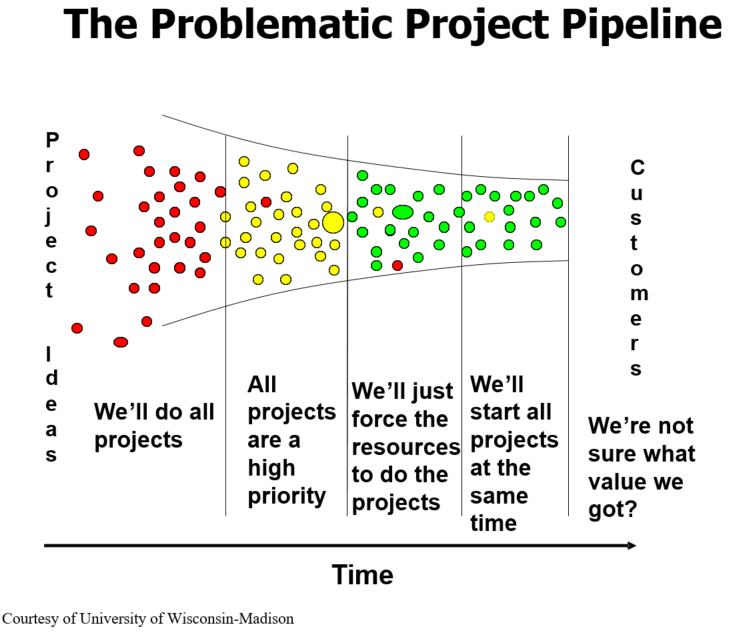
Part 1: The Problematic Pipeline
By: Barb Schrage
Unrealistic deadlines, scope creep, poorly defined goals, everything has to get done now, or whatever familiar refrain knocks around your organization, know that you’re not alone. Students in my professional development Project Portfolio Management class empathize with each other over these situations and feelings of being so overwhelmed, they don’t know where to start. There are solutions.
Project Portfolio Management is a set of business processes that allows organizations to select the right projects at the right time to achieve strategic business goals. The approved project portfolio represents clear direction and priorities for investments in budgets and in resource allocations toward the projects within that portfolio.
Here is a representation of the project pipeline in a non-project portfolio managed environment:

1. Without an organization’s ability to prioritize proposed projects against each other, using criteria that directly ties to the organization’s strategic and business plans, it ends up being an implied decision to do all the projects because they’re all “high” priority.
2. Without an organization’s understanding of the resource capacity (resources’ time and money), it ends up as an implied direction to force the resources to do all the projects, which leads to working excessive overtime or slowing down the pace of the projects to fit the resource capacity.
3. Projects are started based on their sense of urgency or business value. However, without a collective view of priority and business value across all proposed projects that are vying for scarce resources, an organization may end up working on too many projects that have low business value and some that don’t directly tie to an organizations’ strategic and business plans.
4. Without a transparent view of the project portfolio within and across business units, or at the executive level, can lead to a lack of clarity of priorities of where to allocate resources. This may result in projects being worked on with inconsistent decision criteria, such as working on the easiest projects, the “pet” projects, or the exciting projects without regard to alignment to the organization’s business strategies nor the business value to be achieved.
5. Starting too many concurrent projects, without due consideration given to resource capacity (people and money), clogs the project “pipeline” and slows down the overall throughput. People spend small amounts of time on many concurrent projects, which stretches out the timelines for each concurrent project instead of focusing efforts on one or two projects at a time.
Barbara Schrage, PMP, MCPM, teaches Project Portfolio Management at the Wisconsin School of Business Center for Professional & Executive Development. To learn more about her upcoming courses, please contact [email protected].
About the Instructor: Barb Schrage

Barbara owns a consulting business called Practical Project Management, LLC. She helps her clients mature their project management practices in various ways, such as implementing Project Management Offices, implementing Project Portfolio Management, and standardizing and improving their project management processes. Besides teaching classes within UW’s Masters Certificate of Project Management series of courses, she also teaches on-site Project Management courses within organizations. In addition, she coaches and mentors leaders of PMOs and Project, Program and Portfolio Managers. Besides her experience in the Financial Services industry, her clients have spanned various industries, such as health care, energy/utility, engineering, manufacturing, biotech research, government, retail, and market research.